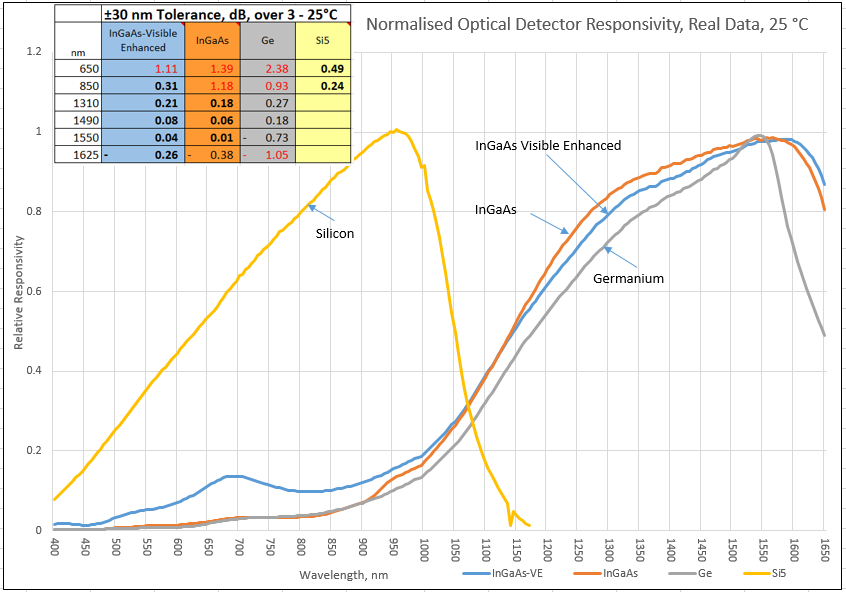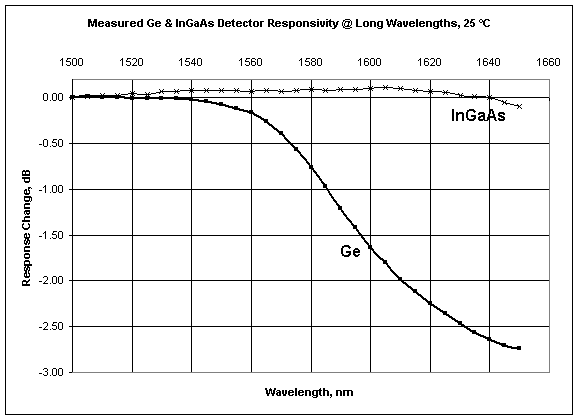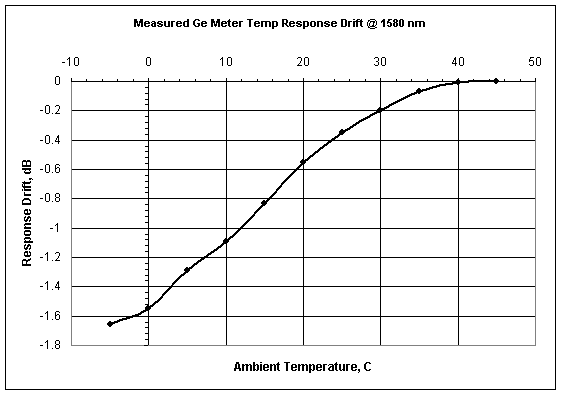19: How to choose an Optical Power Meter Detector


 Introduction
Introduction
The correct detector for loss and power measurements on fiber systems will generally be as follows:
Choose an InGaAs (Indium Gallium Arsenide) detector for:
- General & Precision measurements over 1000 – 1650 nm (other InGaAs detectors) up to up to the maximum meter range.
- CWDM or DWDM bands up to the maximum meter range.
Choose a Ge (Germanium) detector for:
- Modest accuracy over 850 -1550 nm up to the maximum meter range.
Don’t choose a Ge (Germanium) detector for:
- Work on WDM systems above 1550 nm, despite attempts by some competitors to say otherwise. If in any doubt, just look at the graph below. Calibration constants vary by about 2 dB between 1550 and 1625 nm, and are also very temperature sensitive.
- 1550 nm systems if cold temperatures are expected.
- Precision or laboratory grade accuracy. Ge is inherently non-linear by about 0.04 dB, has some temperature sensitivity, and responsivity is more variable across the detector surface.
Choose an Si (Silicon) detector for:
- Precision measurement at 600 – 1000 nm up to the maximum meter range.
Choose an H Series (Attenuated Indium Gallium Arsenide) detector for:
- High power Measurements. These detectors are more expensive and have slightly lower accuracy than normal InGaAs detectors, so only specify them if actually required. Kingfisher power meters can be used up to the maximum display range.
- The peak signal power must be within the meter range.
- High power meters have less Autotest sensitivity, which is a consideration for loss testing.
- The KI2600-H5 offers the best balance for most high power users, with up to +24 dBm range & reasonable Autotest senstivity
- The KI2600XL-H3B offers the highest power level of +33 dBm
What is the Maximum System Power Level going to be?
The large majority of LAN / Telco digital transmission systems have maximum power levels below +5 dBm.
Specialist systems, typically rf / analogue, without an optical amplifier, have maximum power levels below +15 dBm.
Long distance systems with an optical power amplifier have maximum power levels below +23 dBm.
On installed single mode systems with standard polished-fiber connectors (SC / LC / FC etc), total system power per fiber cannot go above +23 dBm per fiber, owing to connector power density limitations.
In fact for routine operations, +18 dBm is regarded as a maximum, above which special operational precautions are needed to avoid catastrophic connector / system failure.
Anything above +23 dBm is highly specialised, and will be either an r&d system, or will have expanded beam connectors to handle the extreme power density, or no connectors.
What is the Minimum System Power Level going to be?
It’s rare to encounter system power levels below -35 dBm.
Use of a fiber amplifier pre-amp can extend recover sensitivity down to between -40 to -45 dBm.
Use of a power meter on a cabling system below about -45 dBm is problematic, due to the possibility of stray sunlight leaking into exposed cabling.
Wavelength Dependence

Detector responsivity graphs @ long wavelengths

The above graph shows the room temperature response of power meters with Ge & InGaAs detectors as the wavelength is changed beyond 1500 nm. The Ge meter is unsuitable for work on CWDM and DWDM systems above 1550 nm, the InGaAs meter is obviously a much better choice, since it is very stable. This graph uses real measurement data.

The above graph shows how the 1580 nm thermal response of a power meter with a Ge detector changes with temperature. This instability makes Ge power meters basically unsuitable for field work on CWDM and DWDM systems above 1550 nm. The thermal stability below 1550 nm is much better, around 0.2 dB, however it’s never as good as InGaAs. This graph uses real measurement data.